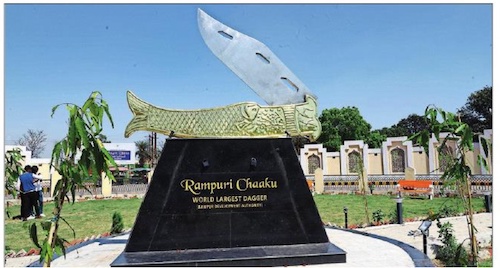Rampuri chaaqu/ knife
(Created page with "{| class="wikitable" |- |colspan="0"|<div style="font-size:100%"> This is a collection of articles archived for the excellence of their content.<br/> Additional information ma...") |
Latest revision as of 19:35, 24 April 2023
This is a collection of articles archived for the excellence of their content. |
[edit] YEAR-WISE DEVELOPMENTS
[edit] As in 2023
Sandeep Rai & Sanjeev Gupta, TNN, April 9, 2023: The Times of India

From: Sandeep Rai & Sanjeev Gupta, TNN, April 9, 2023: The Times of India
Yeh bachchon ke khelne ki cheez nahi…’ When ‘Jaani’ Raj Kumar plucked a knife from screen baddie Madan Puri’s hands and admonished him with these words in the 1965 hit Waqt, he made the Rampuri chaku an overnight celebrity. By the late-1980s, the blade that flips open from its case with the press of a button, or is pulled out by hand, had become the favourite weapon of Bollywood villains. Then it cut into real life – Rampuris used to be a prized possession, especially in smalltown India.
But the sheen wore off suddenly when the UP government banned the sale of blades measuring over 6 inches, in the mid-1990s. “Bollywood made it famous but it also became the reason for its demise,” said Shahvez Miyan, one of the few Rampuri knife manufacturers in Rampur now.
Nawabi Heritage
Rampur is a small, politically active town of former nawabs in central Uttar Pradesh. Shehzad Alam, 50, a fourth-generation knife-maker, said the tradition of knife-making started “around 125 years ago when the nawab of Rampur, Muhammad Mushtaq Ali Khan, called the state’s renowned ironsmith, Ustad Bech Khan, showed him an Italian dagger, and asked him if he could make a copy. ” The ustad replied he could do better than the original, said Alam, and the rest is history. In the 1980s, “almost half of Rampur” was busy churning out knives. They were shipped to other states, and also sold openly at various fairs, said Mohd Yameen, another knife-maker.
Manufacturing the knife is a multistage process that includes the melting of iron strips, casting of the blade, casting of the bronze handle, etc. Others work on the complex gear mechanism that activates the folded knife. “There was a timewhen about 400 licences were issued to karigars (artisans) and thousands of others were indirectly associated with the vocation,” said a knife-maker. The chaku became Rampur’s claim to fame, but after the ban the town’s karigars took up other trades. Many left Rampur. Chaku Bazaar, which boasted dozens of shops in just one locality and had a substantial population engaged in the many processes of knife-making, has just two shops left now. “You don’t need a Rampuri knife to commit murder,” said Yameen, ruefully.
Getting Its Edge Back
However, 28 years after the ban, the local administration recently built a 20-foot model of the oncefamous knife at a crossing and christened it Chaku Chowk. The inscription on it says: ‘World’s largest dagger’.
Efforts are now on to revive the knife’s legacy and make it on an industrial scale. Moradabad divisional commissioner Aunjaneya Kumar Singh, who took the initiative to revive the dagger three years ago when he was the district magistrate of Rampur, told TOI: “We are fighting on several fronts. First, there is the mindset that knives are bad and illegal. For instance, police apprehended a Rampuri knife-maker in Delhi, where he had gone to present his product at an event. I had to intervene. No law was broken, the blade was not longer than six inches and the entire dagger was within the nine-inch limit. ”
Singh said the next step is to make the knives marketable. “We do not want the government to bring about any change in the law. It is not required. These knives can be sold as framed souvenirs. We are certainly trying to convince the government to allow the manufacture and export of daggers with longer blades as they are not banned in other countries. We are moving in a positive direction on this matter. ”